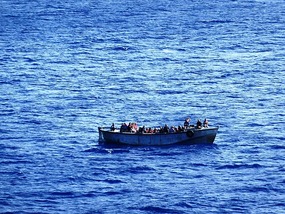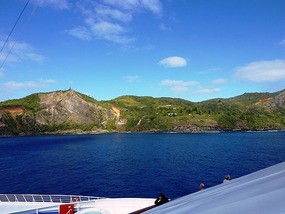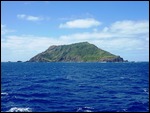The Mutiny on the Bounty was a mutiny aboard the British Royal Navy ship HMS Bounty in April 1789. The mutiny was led by Fletcher Christian against their captain, Lieutenant William Bligh. It is thought that the sailors were attracted to the "idyllic" life afforded on the Pacific island of Tahiti and that they were motivated by Bligh's allegedly harsh treatment of them, although other accounts have Bligh being one of the less harsh captains of the time.
The Royal Navy bought the Bounty for a single mission – she was to travel to Tahiti; pick up breadfruit plants; and transport them to the West Indies, in the hope that they would grow well there and become a cheap source of food for the plantation slaves
.
While waiting for the collected Breadfruit plants to be big enough to transport, the crew of the Bounty were allowed to live ashore and enjoy the Tahitian lifestyle. This loss of military structure is thought to be one of the leading factors in why the mutiny happened – why would you give up the freedom of a tropical island to rejoin the life of rules and regulations aboard a ship.
The mutiny occurred 1,300 miles west of Tahiti. Fletcher Christian had that considered making a raft and deserting the ship by paddling around 30 nautical miles to the nearby island of Tofua but instead he and several of his followers entered Bligh's cabin. Bligh was awakened and, wearing only his nightshirt, pushed on deck where he was guarded by Christian holding a bayonet. When Bligh entreated Christian to be reasonable, Christian would only reply: "I am in hell, I am in hell!" Despite strong words and threats on both sides, the ship was taken bloodlessly and apparently without struggle by any of the loyalists except Bligh himself
. Of the 42 men on board aside from Bligh and Christian, 18 joined the mutiny, two were passive, and 22 remained loyal to Bligh.
The mutineers ordered Bligh, the ship's master, two midshipmen, the surgeon's mate (Ledward), and the ship's clerk into Bounty's launch. Several more men voluntarily joined Bligh rather than remaining aboard, as they knew that those who remained on board would be considered de jure mutineers under the Articles of War. Bligh somehow returned to civilization, while the mutineers sailed the Pacific looking for a suitable island.
The mutineers passed through the Fiji and Cook Islands, but feared that they would be found there. Continuing their search, they rediscovered Pitcairn Island, which had been misplaced on the Royal Navy's charts. After the decision was made to settle on Pitcairn, livestock and other provisions were removed from Bounty. To prevent the ship's detection, and anyone's possible escape, the ship was burned on 23 January 1790
. Even though the Bounty was scuttled by the mutineers over 200 years ago, parts of the ship wreck are still visible in the waters of Bounty Bay. Her rudder is displayed in the Fiji Museum in Suva. An anchor of Bounty was recovered by Luis Marden in Bounty Bay in 1957.
Life on the island switched between idyllic and murderous. Most of the mutineers met unpleasant ends, the Tahitian women who had been kidnapped tried to escape with limited success. Eventually peace was restored on the island.
The infamous British Overseas Territory of the Pitcairn Islands is actually comprised of four separate islands – Pitcairn, Ducie, Oeno and Henderson. Located 2170 km east, south east of Tahiti and just over 6600km from Panama, Pitcairn Island is one of the remotest inhabited islands in the world and the only one of the four to be inhabited. This remoteness is only added to when you consider that the Island's administrative headquarters is situated in Auckland, over 5000km away
.
The plan for some scenic cruise (aka staying on the ship, while it sailed around). While it was exciting, it was also a little on the cold and windy side… perhaps to prepare us for our return to the depths of winter.
As a bit of a treat while we sailed around the island, several members of the Pitcairn community came onboard, set up some small stalls and gave a short lecture on what life is like on the island. The lecture was interesting as it gave us some insight into how the community lives together and the facilities they have on the island. The stalls sold mainly handicrafts, fridge magnets and t-shirts, all of which were very much on the pricey side (think $7 for a fridge magnet). Being a good passenger (who really wanted something saying Pitcairn Island), I handed over my money and smiled excitedly as a kid with the last name Christian gave me a fridge magnet made by the hand of the offspring of a mutineer.
There is a supply ship that restocks the island and the general store on a some what regular basis and a doctor resides on the island
. Given most of the inhabitants are fairly religious, it unsurprising to hear that the islands church plays a strong role in their lives. Two of the more interesting things I learnt was that the power is turned off each night at 10pm (at which point the island is silent) and the daily lighting to the wood powered water heater is 'just a part’ of the island routine.
In terms of income, in addition to the occasional cruise ship, the island has a thriving honey industry. The remoteness of the island means that its bees are free of many of the diseases that plague other countries and the flora of the island produces honey that has its own unique flavour.
As it is a small island, it didn’t take very long to sail around and we had offloaded our Pitcairn Island visitors and were on our way towards Tahiti just after lunch time.
The excitement of seeing the island combined with the not so warm weather, was too much for me and I retired to the cabin for what I thought would be a rest… instead it was the beginning of the sickness.
Fun fact:
Most of the inhabitants of the island are direct descendents of mutineers and their Tahitian companions. Several of the stall holders we met were the great, great some things of the instigator of the whole thing, Fletcher Christian.
MUTINTY!
Friday, August 15, 2014
 Pitcairn Island, United States
Pitcairn Island, United States
Other Entries
-
73It’s a little bit warm
Jul 2917 days prior At Sea, Venezuelaphoto_camera0videocam 0comment 0
At Sea, Venezuelaphoto_camera0videocam 0comment 0 -
74Let there be bubbles
Jul 3016 days prior Bonaire, Netherlands Antillesphoto_camera14videocam 0comment 0
Bonaire, Netherlands Antillesphoto_camera14videocam 0comment 0 -
75Emergency!
Jul 3115 days prior At Sea, Colombiaphoto_camera1videocam 0comment 0
At Sea, Colombiaphoto_camera1videocam 0comment 0 -
76It’s all about gravity
Aug 0114 days prior Panama Canal, Panamaphoto_camera17videocam 0comment 4
Panama Canal, Panamaphoto_camera17videocam 0comment 4 -
77It’s time to pack
Aug 0213 days prior At Sea, Internationalphoto_camera0videocam 0comment 0
At Sea, Internationalphoto_camera0videocam 0comment 0 -
78Stuck in transit
Aug 0312 days prior Manta, Ecuadorphoto_camera5videocam 0comment 1
Manta, Ecuadorphoto_camera5videocam 0comment 1 -
79Escaping Ecuador
Aug 0411 days prior Lima, Peruphoto_camera2videocam 0comment 0
Lima, Peruphoto_camera2videocam 0comment 0 -
80LAMA!
Aug 0510 days prior Aguas Calientes, Peruphoto_camera18videocam 0comment 2
Aguas Calientes, Peruphoto_camera18videocam 0comment 2 -
81The city in the mist
Aug 069 days prior Machu Picchu, Peruphoto_camera20videocam 0comment 4
Machu Picchu, Peruphoto_camera20videocam 0comment 4 -
82Looking around Lima
Aug 078 days prior Lima, Peruphoto_camera8videocam 0comment 0
Lima, Peruphoto_camera8videocam 0comment 0 -
83Why can’t I stay awake?
Aug 087 days prior At Sea, Internationalphoto_camera0videocam 0comment 0
At Sea, Internationalphoto_camera0videocam 0comment 0 -
84Chilly
Aug 096 days prior At Sea, Internationalphoto_camera0videocam 0comment 0
At Sea, Internationalphoto_camera0videocam 0comment 0 -
85Super Moon
Aug 105 days prior At Sea, Internationalphoto_camera0videocam 0comment 0
At Sea, Internationalphoto_camera0videocam 0comment 0 -
86Sitting outside in the rain
Aug 114 days prior At Sea, Internationalphoto_camera0videocam 0comment 1
At Sea, Internationalphoto_camera0videocam 0comment 1 -
87And mysterious it will remain
Aug 123 days prior Easter Island, Chilephoto_camera8videocam 0comment 2
Easter Island, Chilephoto_camera8videocam 0comment 2 -
88Um, the ship has stopped
Aug 132 days prior At Sea, Internationalphoto_camera0videocam 0comment 0
At Sea, Internationalphoto_camera0videocam 0comment 0 -
89Someone closed the doors
Aug 141 day prior At Sea, Internationalphoto_camera2videocam 0comment 1
At Sea, Internationalphoto_camera2videocam 0comment 1 -
90MUTINTY!
Aug 15 Pitcairn Island, United Statesphoto_camera6videocam 0comment 2
Pitcairn Island, United Statesphoto_camera6videocam 0comment 2 -
91Heave ho
Aug 161 day later At Sea, Internationalphoto_camera3videocam 0comment 1
At Sea, Internationalphoto_camera3videocam 0comment 1 -
92Arg!
Aug 172 days later At Sea, French Polynesiaphoto_camera0videocam 0comment 2
At Sea, French Polynesiaphoto_camera0videocam 0comment 2 -
93Le Trucks
Aug 183 days later Papeete, French Polynesiaphoto_camera13videocam 0comment 0
Papeete, French Polynesiaphoto_camera13videocam 0comment 0 -
94La orana Moorea
Aug 194 days later Moorea, French Polynesiaphoto_camera11videocam 0comment 1
Moorea, French Polynesiaphoto_camera11videocam 0comment 1 -
95Time to get crafty again
Aug 205 days later At Sea, Cook Islandsphoto_camera2videocam 0comment 2
At Sea, Cook Islandsphoto_camera2videocam 0comment 2 -
96Well that’s awkward
Aug 216 days later At Sea, American Samoaphoto_camera0videocam 0comment 1
At Sea, American Samoaphoto_camera0videocam 0comment 1 -
97Talofa American Samoa
Aug 227 days later Pago Pago, American Samoaphoto_camera7videocam 0comment 3
Pago Pago, American Samoaphoto_camera7videocam 0comment 3 -
98Not as warm as it once was
Aug 238 days later At Sea, Tongaphoto_camera0videocam 0comment 0
At Sea, Tongaphoto_camera0videocam 0comment 0 -
99The final performance… no more encores
Aug 249 days later At Sea, Tongaphoto_camera2videocam 0comment 0
At Sea, Tongaphoto_camera2videocam 0comment 0 -
100The day that we got an hour at a time
Aug 2510 days later International Date Line, Internationalphoto_camera0videocam 0comment 1
International Date Line, Internationalphoto_camera0videocam 0comment 1 -
101Let us eat cake
Aug 2611 days later At Sea, Internationalphoto_camera1videocam 0comment 0
At Sea, Internationalphoto_camera1videocam 0comment 0 -
102Time for the beanie and gloves
Aug 2712 days later Auckland, New Zealandphoto_camera8videocam 0comment 0
Auckland, New Zealandphoto_camera8videocam 0comment 0 -
103So the sea is a little angry
Aug 2813 days later At Sea, Internationalphoto_camera3videocam 0comment 0
At Sea, Internationalphoto_camera3videocam 0comment 0 -
104It’s a party
Aug 2914 days later At Sea, Internationalphoto_camera5videocam 0comment 0
At Sea, Internationalphoto_camera5videocam 0comment 0 -
105I think the clothes have been breeding…
Aug 3015 days later At Sea, Internationalphoto_camera3videocam 0comment 0
At Sea, Internationalphoto_camera3videocam 0comment 0 -
106Farewell temporary home
Aug 3116 days later Sydney, Australiaphoto_camera2videocam 0comment 1
Sydney, Australiaphoto_camera2videocam 0comment 1

 Pitcairn Island, United States
Pitcairn Island, United States




















2025-05-22